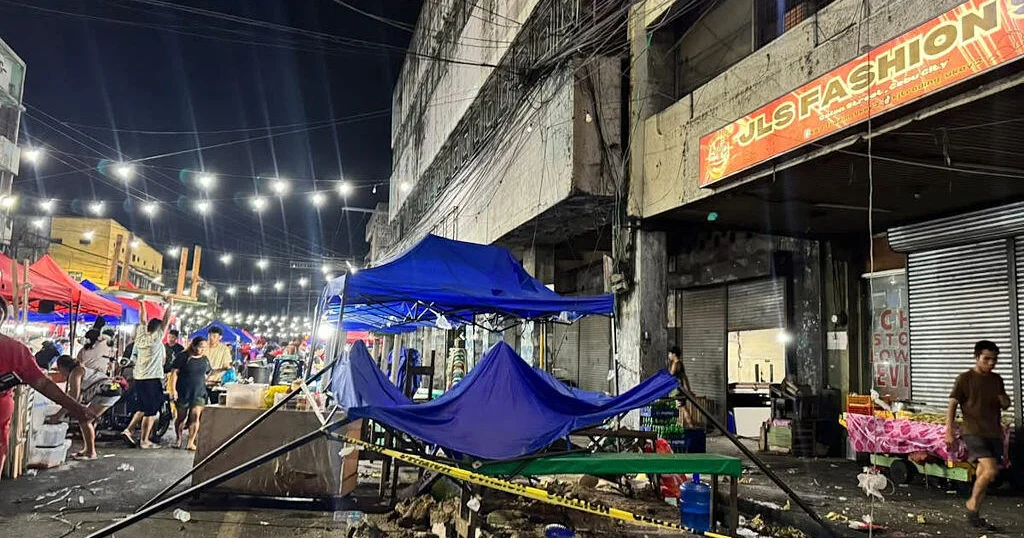A powerful offshore earthquake measuring 6.9 on the Richter scale struck late Tuesday, causing widespread destruction in a central Philippine province. The quake devastated structures, leading to at least 31 confirmed fatalities and many injuries as residents sought refuge amidst falling debris and loss of electricity. Officials stated that the epicenter was located close to Bogo, a city in Cebu province, where local authorities have begun search and rescue operations to assist those affected.
| Article Subheadings |
|---|
| 1) Epicenter and Immediate Effects |
| 2) Casualties and Structural Damage |
| 3) Response and Rescue Operations |
| 4) Community Impact and Call for Aid |
| 5) Broader Context of Natural Disasters |
Epicenter and Immediate Effects
The earthquake struck just before midnight, registering a magnitude of 6.9. The epicenter was identified approximately 12 miles northeast of Bogo, a coastal city that is home to around 90,000 residents in Cebu province. The quake was triggered by the movement of a local fault, occurring at a depth of around 3 miles. Eyewitness accounts describe intense shaking which resulted in panic among local residents. The power outages that followed compounded fears, leaving many in darkness as they fled their homes in a state of disorientation.
Casualties and Structural Damage
As of the latest reports, at least 31 individuals lost their lives due to the quake, with the number expected to rise as rescue efforts continue. The fatalities included victims caught unaware in their homes, particularly in the town of Medellin, where ceilings and walls collapsed while families were asleep. In the nearby town of San Remigio, five individuals, including three coast guard personnel, were killed when walls fell as they attempted to escape a basketball court where they were attending an event. Damage reports included collapsed structures, compromised roads, and devastation to local service facilities like fire stations.
Response and Rescue Operations
Local officials, including disaster-mitigation officers, are spearheading immediate search and rescue operations. The priority is to locate survivors trapped under the rubble in various affected areas, particularly in Medellin and San Remigio. Rescue personnel faced significant challenges due to hazards such as landslides and unstable structures, as highlighted by Glen Ursal, a disaster officer who emphasized the difficulty of moving heavy equipment like backhoes into the chaotic regions. Hospitals began receiving patients with severe injuries as responders worked diligently to provide first aid and transport the injured to medical centers.
Community Impact and Call for Aid
Community leaders have raised alarms regarding immediate needs for food and water, especially in San Remigio, where the water system was reported damaged. Residents have been congregating in open spaces away from their homes, hesitant to return despite the earthquake’s initial shock subsiding. Cebu Governor Pamela Baricuatro stated that further evaluations are necessary to fully ascertain the scale of destruction, urging residents to remain vigilant. Video messages have been circulated, appealing for assistance from higher authorities and aid organizations.
Broader Context of Natural Disasters
The Philippines is notorious for being situated along the Pacific “Ring of Fire,” making it prone to numerous earthquakes and volcanic eruptions annually. Apart from this recent earthquake, the country has experienced severe weather conditions leading to floods and fatalities from recent storms, which left at least 27 dead in the central region just a few days prior. The cumulative toll of natural disasters has heightened the need for effective disaster preparedness and rapid response measures across affected regions to minimize loss of life and property damage.
| No. | Key Points |
|---|---|
| 1 | A powerful 6.9 magnitude earthquake struck near Bogo, Cebu, late Tuesday. |
| 2 | At least 31 casualties reported, including fatalities and severe injuries among residents. |
| 3 | Local officials and workers are engaged in ongoing search and rescue operations. |
| 4 | Community leaders are urgently requesting food and water aid for affected residents. |
| 5 | The earthquake is part of a broader pattern of natural disasters impacting the region. |
Summary
The recent earthquake in Cebu province highlights the ongoing challenges that the Philippines faces with regard to natural disasters. As search and rescue efforts continue, the local community grapples with the immediate aftermath of loss and destruction. The collaboration of local authorities and the reliance on support from aid organizations will be pivotal in the coming days as the situation evolves. This event once again underscores the urgency for robust infrastructure and preparedness strategies in a region susceptible to frequent seismic activity.
Frequently Asked Questions
Question: What are the immediate effects of a 6.9 magnitude earthquake?
Immediate effects can include significant structural damage, loss of life, injuries among residents, and disruptions to basic services such as power and water supply.
Question: How does the Philippines prepare for earthquakes?
The country has established disaster management protocols, including regular drills, public education campaigns, and the involvement of local communities in emergency preparedness efforts.
Question: What geological features contribute to frequent earthquakes in the Philippines?
The Philippines is located on the Pacific “Ring of Fire,” an area characterized by a high frequency of seismic activity due to tectonic plate movements.


